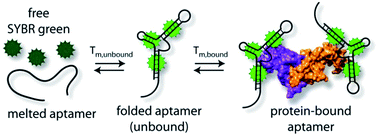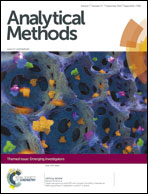Quantifying aptamer–protein binding via thermofluorimetric analysis†
Abstract
Effective aptamer-based protein assays require coupling to a quantitative reporter of aptamer–protein binding. Typically, this involves a direct optical or electrochemical readout of DNA hybridization or an amplification step coupled to the readout. However, method development is often hampered by the multiplicity of aptamer-target binding mechanisms, which can interfere with the hybridization step. As a simpler and more generalizable readout of aptamer–protein binding, we report that thermofluorimetric analysis (TFA) can be used to quantitatively assay protein levels. Sub-nanomolar detection (0.74 nM) of platelet-derived growth factor (PDGF) with its corresponding aptamer is shown as a test case. In the presence of various DNA intercalating dyes, protein-bound aptamers exhibit a change in fluorescence intensity compared to the intercalated, unbound aptamer. This allows thermal resolution of bound and unbound aptamers using fluorescence melting analysis (−dF/dT curves). Remarkably, the homogeneous optical method allows subtraction of autofluorescence in human serum, giving PDGF detection limits of 1.8 and 10.7 nM in serum diluted 1 : 7 and 1 : 3, respectively. We have thus demonstrated that bound and unbound aptamers can be thermally resolved in a homogeneous format using a simple qPCR instrument—even in human serum. The simplicity of this approach provides an important step toward a robust, generalizable readout of aptamer–protein binding.

- This article is part of the themed collection: Emerging Investigators

 Please wait while we load your content...
Please wait while we load your content...